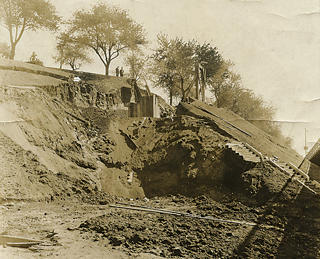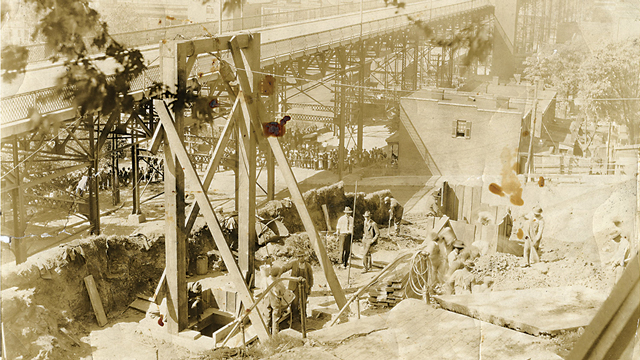By 1872, the narrow strip of land between the James River and Church Hill was too crowded with development to allow easy passage for goods. That’s when work began on a tunnel so cargo could be moved quickly between Shockoe Bottom and the deepwater terminal which provided waterborne access to a number of international partners.
In response, the Chesapeake and Ohio Railroad Company surveyed a one-mile underground route that cut diagonally across the street grid: from 29th and Grace Streets to 19th and Marshall Streets. Work progressed slowly, as the soil proved to be largely composed of blue marl – a type of clay that is brittle when dry, but absorbs moisture readily. When wet, blue marl turns very slippery and unstable. During construction, cave-ins killed workers, damaged homes, and completely destroyed Third Presbyterian Church.
 The company remained determined, however, and the first train passed through the completed tunnel in late 1873. In the next few decades, development outpaced the capacity of the tunnel, and C&O eventually built a trestle along the river. The trestle opened and the tunnel closed in 1901. But evermore expanding industry would compel the company to reuse the tunnel to relieve congested trestle traffic in 1925. With that, C&O put their employees to work in an effort to repair the long-neglected tunnel.
The company remained determined, however, and the first train passed through the completed tunnel in late 1873. In the next few decades, development outpaced the capacity of the tunnel, and C&O eventually built a trestle along the river. The trestle opened and the tunnel closed in 1901. But evermore expanding industry would compel the company to reuse the tunnel to relieve congested trestle traffic in 1925. With that, C&O put their employees to work in an effort to repair the long-neglected tunnel.
On the rainy afternoon of October 2, 1925, after a week of dismal skies and showers, an estimated 200 workers were inside when bricks began to fall from the ceiling. Witnesses described a terrible roar as the hill at the western end – home to Jefferson Park – collapsed around them. For the workers in the tunnel, running three-quarters of a mile toward the eastern portal ended up being a safer route than running a hundred feet to the western exit. There, a small work engine and flat cars became entombed in clay.
When the company checked their roster against the survivors, they determined that three men were still trapped inside the tunnel. Many workers contested that number, saying new employees had shown up that day who had not yet been added to the rolls. They estimated ten to fifteen trapped workers. Either way, rescue efforts began near the western portal. A steam shovel dug straight down through the Church Hill park. The slippery clay slowed efforts and threatened further cave-ins. Nine days later, rescuers reached the work engine, where they found the body of the engineer. Further excavations were deemed too dangerous on the unstable site to reclaim the bodies of two workers known to be trapped, along with any others who may have been uncounted on that fateful day. Soon after, C&O filled the tunnel with sand to stabilize it and sealed the portals with caps, which are still in place today.
Photos: Lowman, The Valentine








